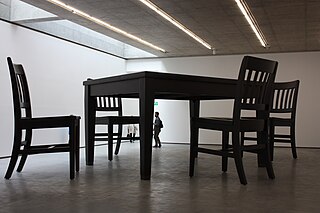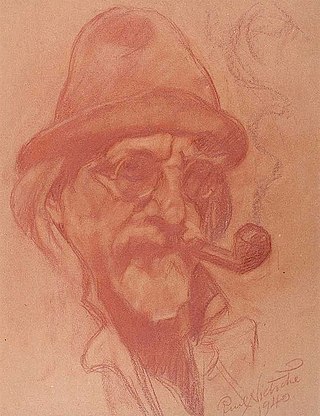Anne Madden is an English-born painter, who is well known in both Ireland and France where she has divided her time since her marriage to Louis le Brocquy in 1958.

Richard Serra is an American artist known for his large-scale sculptures made for site-specific landscape, urban, and architectural settings. Serra's sculptures are notable for their material quality and exploration of the relationship between the viewer, the work, and the site. Since the mid-1960s, Serra has worked to radicalize and extend the definition of sculpture beginning with his early experiments with rubber, neon, and lead, to his large-scale steel works.

The Irish Museum of Modern Art, also known as IMMA, is Ireland's leading national institution for the collection and presentation of modern and contemporary art. Located in Kilmainham, Dublin, the Museum presents a wide variety of art in a changing programme of exhibitions, which regularly includes bodies of work from its own collection and its education and community department. It also aims to create more widespread access to art and artists through its studio and national programmes.
Basil Joseph BlackshawHRUA, HRHA was a Northern Irish artist specialising in animal paintings, portraits and landscapes and an Academician of the Royal Ulster Academy.
Colin Middleton was a Northern Irish landscape artist, figure painter, and surrealist. Middleton's prolific output in an eclectic variety of modernist styles is characterised by an intense inner vision, augmented by his lifelong interest in documenting the lives of ordinary people. He has been described as ‘Ireland's greatest surrealist.’

Paul Seawright is a Northern Irish artist. He is the professor of photography and the Deputy Vice Chancellor at Ulster University in Belfast/Derry/Coleraine. Seawright lives in his birthplace of Belfast.

Elizabeth Murray was an American painter, printmaker and draughtsman. Her works are in many major public collections, including those of the Solomon R. Guggenheim Museum, the Hirshhorn Museum and Sculpture Garden, the Pérez Art Museum Miami, the Museum of Modern Art, the Whitney Museum of American Art, the San Francisco Museum of Modern Art, the Art Institute of Chicago, the Carnegie Museum of Art, and the Wadsworth Atheneum. Murray was known for her use of shaped canvases.

Michael Smith is an American artist known for his performance, video and installation works. He emerged in the mid-1970s at a time when performance and narrative-based art was beginning to claim space in contemporary art. Included among the Pictures Generation artists, he also appropriated pop culture, using television conventions rather than tropes from static media. Since 1979, much of Smith's work has centered on an Everyman character, "Mike," that he has portrayed in various domestic, entrepreneurial and artistic endeavors. Writers have described his videos and immersive installations as "poker-faced parodies" that sit on the edge between art and entertainment, examining ideas, cultural shifts and absurdities involving the American dream, consumerism, the art world, and aging. Village Voice critic Jerry Saltz called Smith "a consummate explorer of the land of the loser … limning a fine line between reality and satire [in] a genre sometimes called installation verité."
Walter "Chico" Hopps was an American museum director, gallerist, and curator of contemporary art. Hopps helped bring Los Angeles post-war artists to prominence during the 1960s, and later went on to redefine practices of curatorial installation internationally. He is known for contributing decisively to “the emergence of the museum as a place to show new art.”

Kenneth Price was an American artist who predominantly created ceramic sculpture. He studied at the Chouinard Art Institute and Otis Art Institute in Los Angeles, before receiving his BFA degree from the University of Southern California in 1956. He continued his studies at Chouinard Art Institute in 1957 and received an MFA degree from New York State College of Ceramics at Alfred University in 1959. Kenneth Price studied ceramics with Peter Voulkos at Otis and was awarded a Tamarind Fellowship.

Ted Stamm (1944-1984) was an American minimalist and conceptualist artist.

Autumn Rhythm is a 1950 abstract expressionist painting by American artist Jackson Pollock in the collection of the Metropolitan Museum of Art in New York City. The work is a distinguished example of Pollock's 1947-52 poured-painting style, and is often considered one of his most notable works.

Paul Winstanley is a British painter and photographer based in London. Since the late 1980s, he has been known for meticulously rendered, photo-based paintings of uninhabited, commonplace, semi-public interiors and nondescript landscapes viewed through interior or vehicle windows. He marries traditional values of the still life and landscape genres—the painstaking transcription of color, light, atmosphere and detail—with contemporary technology and sensibilities, such as the sparseness of minimalism. His work investigates observation and memory, the process of making and viewing paintings, and the collective post-modern experience of utopian modernist architecture and social space. Critics such as Adrian Searle and Mark Durden have written that Winstanley's art has confronted "a crisis in painting," exploring mimesis and meditation in conjunction with photography and video; they suggest he "deliberately confuses painting's ontology" in order to potentially reconcile it with those mediums.

Robert Therrien was an American artist known for his large-scale sculptures. His work reimagined and reinvented objects from everyday life, such as a set of table and chairs or stacks of plates, turning them into monumental immersive sculptures. Los Angeles-based, Therrien was described as being possessed by a sense of wonder over commonplace experiences
Terence Philip FlanaganPPRUA HRUA RHAMBE was a landscape painter and teacher from Northern Ireland.
Charles Vincent Lamb was an Irish landscape and portrait painter.
Romeo ToogoodARCAHRUA was an Ulster artist and teacher who specialized in landscape painting.

Paul Nietsche was a Ukrainian artist and teacher who emigrated to Ulster in 1936 where he became a central figure on the Belfast artistic and literary scenes between the 1930s and his death in 1950.
Cherith McKinstry was an Irish painter and sculptor.
William Robert Gordon HRUA was an influential Northern Irish landscape and portrait painter, and an educator. He was a founding member of the Ulster Arts Club and the Ulster Literary Theatre.











